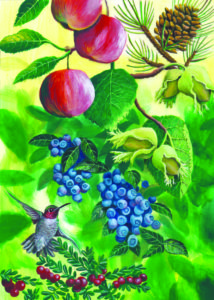
Painting by Gabriel Tempesta www.gabrieltempesta.com
by David Fried of Elmore Roots Fruit Tree and Berry Nursery
It was in the late 70s or very early 80s when I visited my friend who was working at the Rural Education Center in Wilton, New Hampshire. The man who brought permaculture to America, Bill Mollison, had just been there. I bought his books and began the lifelong study and practice of this philosophy.
For the first time, I was shown the relationships between planning and long term results of what we choose to put in our landscapes where we live. I made charts of plants of many uses and had to determine what would grow in northern Vermont, because Mollison’s research was done in Tasmania. I fell in love with the Siberian Peashrub. The unusual green bark yielding bright yellow flowers and little dried peas that are released when the pods dry and “do the twist”. A good protein source for songbirds, chickens and can also grind and add to muffin batter for us people. On top of all this, they fix nitrogen in the soil and can withstand strong winds!
I began making drawings and then planting shrubs and trees based on what area would be smartest for them to grow in on my own land. The black walnuts that would get tall and shade things and did not require much care were planted the farthest away on the edges of the land. Blueberries that I wanted to snack on frequently and would need to be netted were planted closer to the office. In view from our lunch and picnic table, we could tell when the birds were beginning to swoop down on them that it was time to put up the netting!
Grapes and kiwis, because they are vines, need support. We built attractive and strong arbors and used them as entries for walkways and along paths leading out into new parts of our fields. These paths lead to our pears, plums and apples on a slope where they will get plenty of sunlight but would be too steep for vegetables. A flatter area closer to our house made the smartest choice for the garden. There, we can go out first thing in the morning or even an hour before bed and pull a few weeds or collect salad ingredients.
It seems that landscaping “the permaculture way” means using our wisdom to farm smarter not harder. The plants are here to help us, and we need to learn what plants have what qualities and to use them respectfully and thoughtfully. We don’t have much of a say of what goes on in the world around us, but we can plant as many Jerusalem Artichokes or Siberian Peashrubs in key spots around our land as we would like.
In the 1800s there was a summer in Vermont where we did not have more than a few frost-free weeks. Everyone who had them lived on Jerusalem Artichokes. We can plant our favorite pear trees and the Hazelbert bushes we look forward to harvesting. It doesn’t hurt to plant a few others that grow no matter what. Grow vegetables in the garden and establish islands for everything else, where each plant can spread out a little and enjoy its place in the sun.
Bonus tip: each fruit or nut tree that has compost and bark mulch around its base to cut down on grass competition, and they can be used as a plant support for growing pole beans, runner beans, garden peas or flowers. Not only will they produce heavily but many will help fix nitrogen for the fruit trees. It will undoubtedly be an interesting sight!
David Fried is the propagator, grower and writer at Elmore Roots Nursery in Elmore, Vermont.








Leave a Reply